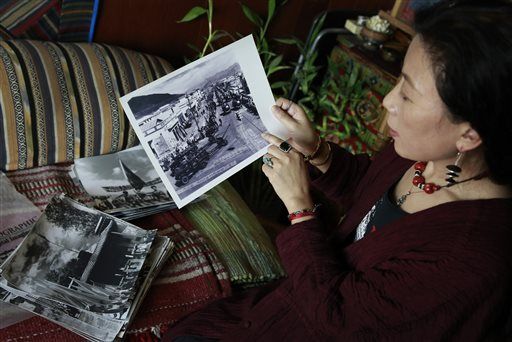
High Peaks Pure Earth has translated a blogpost by Woeser that reflects on her father’s photos of the Cultural Revolution in Tibet.
Originally written for the Mandarin service of Radio Free Asia, this post was published on Woeser’s blog on January 28, 2018. A little confusingly, this article came out in the middle of a long series of posts by Woeser about the Cultural Revolution in Tibet, see all eight parts of that series here: https://highpeakspureearth.com/tag/cultural-revolution/
The Associated Press article from 2015 that Woeser mentions in the opening paragraph is available here: https://www.apnews.com/2a43b75f50884204b9ffb6dfe743798a
“Photos Preserving the Memory of the Cultural Revolution in Tibet”
By Woeser
On March 11, 2015, under the title of “Secret Historians Preserve Past in China Amid State Amnesia”, the Associated Press reported on three people living in Beijing, including myself, who have worked hard many years on recording, storing and making public the dark history of the Chinese Communist Party.
The report stated: “The ruling Communist Party zealously enforces its own version of Chinese history … The government has largely succeeded in erasing or playing down whole swaths of Communist-era history by controlling what’s talked about in the country’s classrooms, museums and books, as well as in other areas of public life.” However, some referred to as “secret historians” have “taken it upon themselves to preserve photos, interview eyewitnesses and do the archival work that the Chinese government has banned most historians inside the country from doing.”
The Associated Press journalist visited me at my home in the eastern suburbs of Beijing and came to see over one hundred photos that do precisely this: they “preserve the past”. These photographs were taken by my late father. They show scenes of destruction in Lhasa and other Tibetan areas as the Cultural Revolution swept across the country. These photographs were secretly developed in 2000 by my husband Wang Lixiong.
Wang Lixiong also took the photos to His Holiness the Dalai Lama and wrote in his book “Dialogue with the Dalai Lama” (published in 2002 by the American Renjian Publishing house, Green Valley Publishing): “My meeting with His Holiness the Dalai Lama was arranged for the second day, on May 24, 2001 … Before I said goodbye, I gave His Holiness a set of photographs taken during the Cultural Revolution in Tibet. A Tibetan who had passed away took these photos. I said to His Holiness: no doubt the experience of the Cultural Revolution is a very painful memory for Tibet, but history is history and one cannot and should not forget it. Tibet has very few mementos left from the Cultural Revolution. Thus these photos are very valuable. His Holiness looked at each photo in good spirits. He recognized in one of the photos a man in a tall hat and painted in the face, being denounced. It was an aristocrat that he once knew very well. Among the photos was one of the Red Guards carrying a large propaganda picture and marching down Bolang Street. In the propaganda picture, a ‘liberated serf’ was sweeping two clown-like persons away, one was “Dalai”, the other was “Panchen”. His Holiness laughed every now and then but did not react when he saw the photo of a female Red Guard with obvious Tibetan features smashing the golden roof of a temple with an axe. Tibetans smashing the temples in which they had worshipped for centuries – this historical period has always been an unexplained puzzle, even for the Dalai Lama.”
I told the Associated Press journalist how over six years I conducted research and interviews in Lhasa and I started writing based on those photos. I interviewed over 70 people, mostly Tibetans, but also some Chinese and Hui people; they included retired cadres, soldiers, workers, residents, a few officials, some scholars still working within the system and devout monks. Some of them had been Red Guards, some part of the “Rebel Factions”, some denounced as “monsters and demons” and others been “enthusiasts”… I carried the photos around Lhasa’s streets and alleys, secretly engaging people in conversations. Gradually, a wiped out era reappeared and a Tibetan past that had fallen into oblivion slowly recovered.
“Fighting the power also means fighting amnesia”. “A lot of people have already died,” I said, “so I think this is a very urgent thing. Because memory is important to people, and if the person is there, the memory is there. If the person isn’t there, then the memory has disappeared.” This collection of photographs and related materials were published in 2006 in Taiwan entitled “Forbidden Memory: The Cultural Revolution in Tibet”. In 2016 a second edition was published with additional photos and text.





Follow Us!